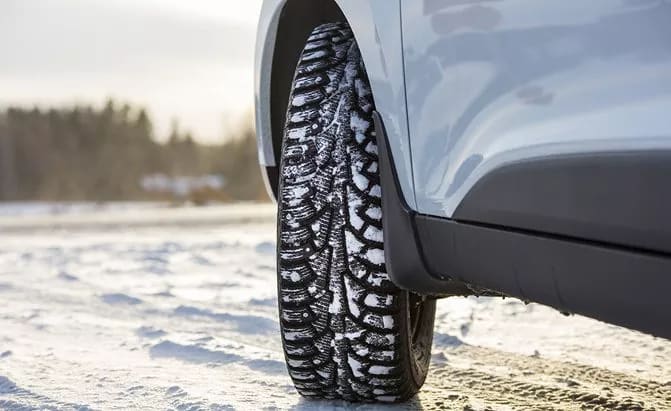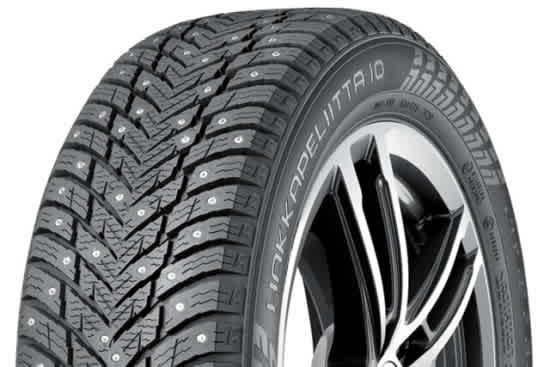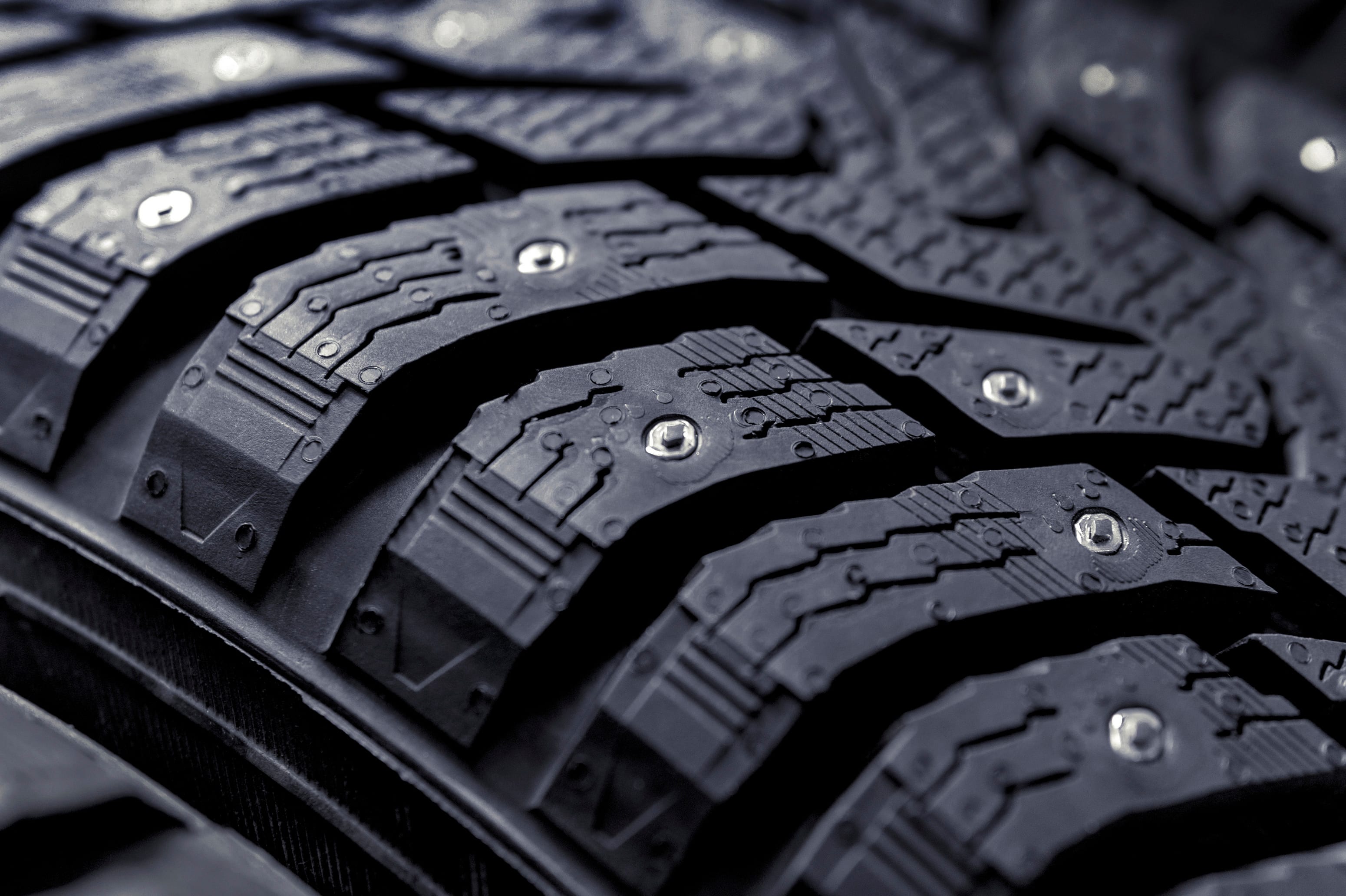Tire Buying Guides
Free shipping
Best price guarantee
Special pricing
Financing with Resolve
Easy returns

Winter driving demands tires that can handle the toughest conditions nature throws at your vehicle. Metal-studded snow tires have served as the go-to solution for extreme ice and snow traction for decades, helping drivers navigate treacherous roads with confidence.
These specialized winter tires feature small metal spikes embedded in the tread that bite into ice like tiny anchors. While advances in tire technology have introduced impressive studless alternatives, studded tires remain a critical safety tool for drivers who face severe winter conditions.
Understanding how studded tires work, when to use them, and whether they're legal in your area helps you make an informed decision about winter tire selection. The choice between studded and studless options depends on your specific driving conditions, local regulations, and performance priorities.
What Are Studded Snow Tires?
Studded snow tires are winter tires equipped with small metal spikes strategically embedded throughout the tread pattern. These lightweight studs — typically made from tungsten carbide or similar hard metals — protrude slightly from the rubber surface to provide enhanced traction on ice-covered roads. Each tire contains dozens to hundreds of these metal studs arranged in a specific pattern across the tread blocks.
The studs themselves measure approximately 12-15 millimeters in length, with only a small portion extending beyond the tire surface. Manufacturers design these tires with deeper tread depths than standard winter tires to accommodate the studs while maintaining adequate rubber thickness for tire integrity. This extra depth requirement often limits the available size options for studded tires compared to their studless counterparts.
Key Components of Studded Tires
- Metal studs: Hard metal pins inserted into pre-molded holes in the tire tread
- Reinforced tread blocks: Specially designed rubber sections that hold studs securely
- Deep tread grooves: Channels that help evacuate snow and slush while studs grip ice
- Staggered stud placement: Strategic positioning to maximize ice contact and minimize road damage
The installation process involves either factory-installed studs or aftermarket stud insertion into specially designed "studdable" tires. Factory-studded tires arrive ready to mount, while studdable tires feature pre-drilled holes where tire shops can insert studs based on local regulations and driver preferences. The number of studs varies by tire size and manufacturer specifications, but most passenger car tires contain between 60 and 120 studs per tire.
How Do Studded Snow Tires Work on Ice and Snow?

Studded snow tires enhance traction on icy and snowy surfaces through their innovative design. Small metal studs embedded in the tire tread engage with the road surface, providing a secure grip. As the tire rolls, these studs penetrate the ice and snow, allowing the tire to make contact with the firmer layer beneath. This interaction significantly boosts the tire's grip, improving the vehicle's handling during acceleration, deceleration, and sharp turns.
The studs are particularly effective on roads covered with hard-packed snow and ice. Unlike regular tires, which may struggle on these slick surfaces, studded tires retain traction, reducing the likelihood of slipping. The studs break through the icy surface layer, providing stability during critical maneuvers. This feature is especially beneficial in sudden stops or quick directional changes, where maintaining control is essential.
While studded tires excel in icy conditions, their performance varies with road conditions. They deliver the best results on untreated surfaces where ice and snow remain compacted. On bare or wet pavement, the metal studs can produce additional noise and may experience quicker wear, affecting their longevity. However, in areas with severe winter weather, the safety and control benefits of studded tires often outweigh these drawbacks.
When Should You Use Studded Snow Tires?
The decision to use studded snow tires hinges on the specific winter conditions typical in your area. These tires prove invaluable in scenarios where ice and compacted snow dominate and road treatment lags. Knowing when to employ them ensures you maximize their benefits while understanding alternatives when conditions allow.
Best Conditions for Studded Tires
In regions with severe winter weather and infrequent road maintenance, studded tires offer a significant advantage. They are particularly useful in rural settings where snowplows may not reach quickly, providing necessary traction on icy roads. Mountain passes with persistently icy conditions also benefit from the enhanced grip of studded tires, which reduce the risk of skidding on steep surfaces.
- Untreated icy roads: The studs penetrate slick surfaces, delivering grip where other tires may slip.
- Unplowed roads with compacted snow: Their ability to dig in ensures stability on densely packed snow.
- Conditions with freezing rain: Studs maintain traction when roads become dangerously slick.
- Persistently icy mountain passes: These areas require the extra grip to safely navigate steep, icy terrain.
- Rural roads with limited maintenance: Infrequent plowing makes studded tires essential for safe travel.
When Studded Tires May Not Be Necessary
In contrast, certain conditions render studded tires less critical. Urban areas often receive regular snow clearance and de-icing treatments, reducing the need for additional traction. Regions that primarily experience slush or wet snow might find studless winter tires more suitable, offering a quieter ride without potential road damage.
- Regularly plowed and treated roads: Frequent maintenance diminishes the necessity for studs.
- Wet snow or slush-dominant areas: Conditions that don't harden into ice benefit less from studs.
- Urban environments with consistent road treatment: Regular plowing and de-icing reduce the reliance on studded tires.
- Mild winter regions: Areas with minimal ice or snow may not justify the use of studded tires.
By understanding the optimal use cases for studded tires, drivers can make informed decisions that ensure safety and efficiency in winter driving conditions.
Are Studded Snow Tires Legal in Your State?

Understanding the legal framework for studded snow tires is crucial. States differ widely in their regulations regarding these tires, often implementing seasonal limits. Typically, jurisdictions that allow studded tires only permit their use during specific winter months, often spanning from mid-winter through early spring, to mitigate potential road damage.
In some regions, the use of studded tires is entirely prohibited. This decision stems from concerns about the damage metal studs can cause to paved surfaces. States with less severe winter weather or where roads receive regular maintenance may decide that the infrastructure costs outweigh the safety benefits, leading to a complete ban. It's essential to be aware of your state's stance, as using studded tires during non-permitted times can lead to fines.
For the most accurate information, consult your state's Department of Transportation. They provide specific guidance on permissible dates and any conditions under which studded tires are allowed. Keeping informed about these regulations helps you avoid penalties and ensures your vehicle is prepared for winter conditions.
Studded vs Studless Snow Tires: Which Performs Better?
Studded snow tires excel in the most challenging winter conditions. The embedded metal studs pierce through glare ice, offering traction that surpasses other tires in severely icy environments. This feature makes them particularly effective on compacted snow, where their penetration ability enhances vehicle stability. Enhanced braking performance on icy surfaces is a key advantage, helping prevent skids and collisions during abrupt stops.
However, studded tires have certain limitations. The studs contribute to increased road noise when driving on clear pavement, which can detract from the comfort of the ride. Additionally, they can cause wear on road surfaces, a concern that has led to their restriction in some areas. These factors make studded tires ideal for severe conditions but less suitable for regions with milder winters or frequent road maintenance.
Studless Snow Tire Performance
Studless snow tires utilize advanced rubber technologies, allowing them to stay pliable even in frigid temperatures. This flexibility supports exceptional traction on both wet and dry winter roads, often outperforming studded alternatives in such conditions. The intricate tread design, with its numerous small grooves, enhances grip by creating more contact points with the road surface.
These tires provide a quieter ride compared to their studded counterparts, making them favorable for use in cities and suburbs. Without metal studs, there's no risk of road damage, allowing for year-round use without legal restrictions. Modern developments in studless tire technology have dramatically improved their effectiveness, equaling or even surpassing studded tires in various winter driving scenarios.
What Are the Benefits and Drawbacks of Studded Snow Tires?

Studded snow tires provide significant advantages in regions with harsh winter climates. Their design allows them to interact effectively with ice-covered surfaces, offering the necessary grip to maintain vehicle stability. This enhances the driver's ability to maneuver safely through challenging winter conditions, especially in areas prone to sudden weather changes. The studs contribute to a more secure drive, ensuring confidence when navigating icy terrains.
With decades of refinement, studded tires stand as a trusted choice for tackling severe winter roads. The technology behind these tires continues to evolve, providing drivers with dependable performance in the most demanding environments. For those facing icy road conditions regularly, the added assurance of reliable traction can be crucial. Knowing your vehicle can handle extreme winter scenarios adds a layer of confidence that is hard to match.
Benefits
- Exceptional ice interaction: Studs penetrate ice, providing stability and control in slippery conditions.
- Enhanced maneuverability on icy roads: Allows for safer navigation through challenging winter weather.
- Stability during sudden weather shifts: Essential for maintaining control when weather conditions change rapidly.
- Reliable in severe winter scenarios: Offers peace of mind with consistent performance.
- Evolving technology: Continuous advancements ensure effectiveness in winter driving.
However, studded snow tires also come with considerations that may affect their suitability for some drivers. Their interaction with the road can generate noticeable noise, which may detract from the comfort of the ride. Additionally, while they excel on ice, their performance may not be as favorable on dry or wet roads. This can lead to differences in handling and potentially affect the driving experience during milder weather.
Drawbacks
- Noticeable noise on clear roads: Interaction with the road surface can produce significant sound levels.
- Variable performance on non-icy roads: May not offer the same level of traction on dry or wet surfaces.
- Potential wear on infrastructure: Metal studs can contribute to road surface degradation.
- Regulatory considerations in certain areas: Some regions impose restrictions due to infrastructure concerns.
- Higher investment than traditional winter tires: Comes with a cost reflecting the specialized design.
- Impact on fuel consumption: Additional friction can lead to increased fuel usage.
Choosing between studded and studless winter tires requires careful evaluation of several important factors. Begin by considering the specific winter challenges you face on the road. If your driving frequently involves navigating through ice and untreated snow, then the superior grip of studded tires could be beneficial. Conversely, in areas where slush and mild snow are more common—alongside regular road treatment—studless tires could offer reliable performance with the added benefits of reduced road noise.
Understanding local weather dynamics and how roads are maintained during winter is essential. In areas with prolonged, intense cold spells and minimal snow removal, studded tires provide necessary traction. However, in locations where snow is promptly cleared and the climate is less extreme, studless tires can perform adequately, delivering a smooth and quiet ride without the need for metal studs.
Legal factors also influence the decision. It's important to check regional laws regarding the use of studded tires, as these can vary significantly. States may implement specific periods during which studded tires are permitted, and using them outside these times could incur penalties. These regulations ensure that drivers balance safety with infrastructure preservation.
Comfort is a key consideration as well. Studded tires can generate noticeable road noise, which might detract from the driving experience. If minimizing noise and prioritizing comfort are essential, studless tires might be preferable due to their quieter operation. Evaluating your priorities for a quiet and comfortable ride helps in making a balanced decision.
Advancements in studless tire technology have significantly improved their ability to handle winter conditions. Modern studless tires incorporate sophisticated tread designs and advanced rubber compounds that provide excellent traction. These features ensure that they remain a competitive option for drivers who face a variety of winter road conditions, offering reliable performance without the drawbacks associated with studs.
Installing and Maintaining Your Studded Snow Tires
Ensuring proper installation of studded snow tires is essential for maximizing their benefits. Rely on a tire specialty shop for installation to ensure the studs are correctly embedded and aligned. These professionals use specialized tools to ensure that each stud is placed accurately, preventing uneven wear and enhancing traction. Having all four tires studded is crucial for maintaining vehicle balance, which helps in stable driving across icy roads.
Timing the installation is key to preparedness. Aim to equip your vehicle with studded tires before the onset of harsh winter conditions. Early installation allows you to avoid last-minute rushes and ensures that your vehicle is ready for snow and ice. Secure storage of your summer tires during winter months is important; it preserves their shape and prevents them from deteriorating.
Maintenance Requirements
Regular maintenance checks are vital to the longevity and performance of studded tires. Inspect the studs periodically to ensure they remain firmly in place, as loose studs can compromise traction. Tread depth should be monitored throughout the winter to ensure it remains sufficient for safe driving on snow and ice.
Maintaining the correct tire pressure is critical, as cold temperatures can cause fluctuations that affect performance. Proper inflation promotes even tread wear and improves fuel efficiency. Be sure to adhere to local regulations regarding the removal of studded tires to avoid penalties. Examine your tires regularly for any missing or damaged studs. Addressing these issues ensures ongoing safety and optimal tire performance.
Making the right winter tire choice protects you and your passengers when road conditions turn dangerous. Whether you choose studded or studless snow tires depends on your unique driving conditions, local regulations, and personal preferences. When you're ready to upgrade your winter driving safety, we make it easy to shop for tires online and find the best deals that match your vehicle and budget.
The cost of studded snow tires could vary depending on your vehicle and which brand of tire you select. A studded snow tire could cost as little as $75 per tire or as much as $500 per tire.
Yes, studded snow tires are worth it if you live in an area that frequently sees heavy ice, slush, and snow when temperatures are consistently below 45 degrees Fahrenheit.
Ready to find the perfect tires?
Search By